Leaves finally came out this week, in literally two days.

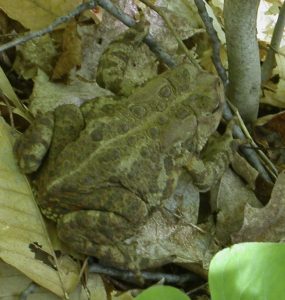
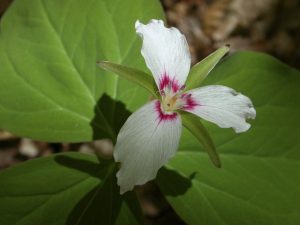


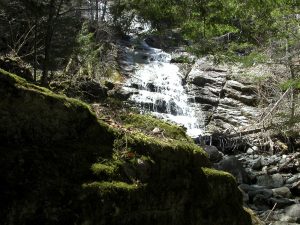
This is Deer Brook Falls, a hike I’ve wanted to go on for weeks, and the trail was finally clear and passable. Photo doesn’t do it justice.
I notice that productivity at New Moon seems slow for me. It’s a time when blockages are cleared, hence it feels like things are stationary. This week I had a major water leak in my kitchen, which has been a distraction. Good thing I’m taking a break from writing.
I think it’s a good thing, working with New Moon energy, to be persistent. This can be a rewarding energy if you have the patience.
A new moon teaches gradualness
and deliberation and how one gives birth
to oneself slowly. Patience with small details
makes perfect a large work, like the universe.
~Rumi
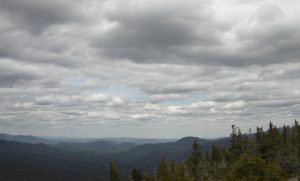
I’m taking a break from writing for awhile. Last week, I finished the draft of yet another novel, submitted another article to an E-zine, and wrote a post on Beltane for this blog. I wonder sometimes why I never get anything done, and I forget that it’s because I’m writing. I have a feeling I would understand my productivity better if I got paid for it.

Wednesday I hiked Blueberry Mountain in Keene, one of the toughest two-and-a-half miles I am acquainted with. About 2,000 foot elevation gain, some of it scary steep. A lot is over bare rock, and there’s one part where I always chicken out and skirt through the brush. I should have taken a picture of that section.
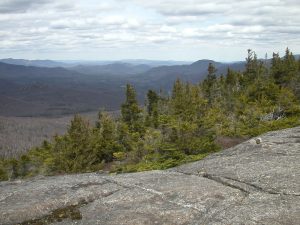
There was a bit of snow and ice uptop and, as you can see from the photos, trees are still bare along the upper slopes, though they are starting to bud in the Valley. Stream crossings on this trail are usually easy, but one was dicey with all the snow melt. I was wearing good boots, so I didn’t get my feet wet, literally, though metaphorically this was a good trail to start the hiking season.
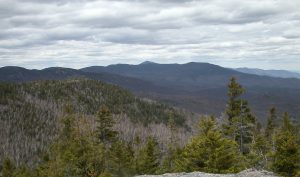
Open water everywhere now! I’ve been hearing Canada Geese from my apartment for weeks. With the reduced traffic from COVID-19 lockdowns, I wonder if even people in the cities can hear them. When I lived in Arizona, they flew so high during migration that they looked like swarms of gnats.
Tired of looking at cats on the Internet? Here’s a duck.

There’s actually a female Mallard nearby in this photo, but she’s impossible to see with her camouflage coloring. Though males are more colorful, females are more vocal.
The Mallard is the most common wild duck, ancestor of the domestic white, found throughout the Northern Hemisphere with slight variations in coloring. This male has a lot of white on its body and a reddish belly and might be confused with a Merganser, also common in this area. The female confirms the identification.
“Like a duck to water,” goes the saying. I took this sighting as a message of being in one’s own element, feeling natural, effortless, and in control.
On an electric pole along the Ausable River, between the villages of Jay and Ausable Forks, I saw a pair of nesting ospreys on Wednesday. They’ve picked this particular site before, and the region experienced a half-day planned electricity outage last year as crews tore down the nest after the chicks were grown. Looked on the map and noticed a pond in a housing development, which may be stocked, flows into the river near this site.

This video, which is amazing, is not the electric pole in question. These birds eat a LOT of fish. They can pull bigger fish than shown here out of the lakes in the Adirondacks.
I’ve been trying to learn to differentiate Osprey, Pileated Woodpecker, Northern Flicker, and Northern Goshawk calls. Sounds doable when comparing recordings, but in the field it’s a bit more challenging.
I take a lot of photos this time of year, as the light accelerates the land of ice and snow into a brown and gray world. Most photos show the Adirondacks in summer or autumn or, more rarely, winter; few depict this time of year. These scenes are meaningful to me partly because this is a landscape that will not last. In fact, it will disappear quickly. There is a tremendous amount of energy building, waiting to be released. This is the point of power, the transformation of one thing into another. To me, this what magic is about.
As we soldier through the Covid-19 pandemic, many are curious about how people are managing in various parts of the world. Here’s my report.

New York State seems to be, outside of Italy, the epicenter of the virus, with most confirmed cases in this state. I say “seems to be,” because we don’t really know. New York is doing more testing per capita than anywhere in the country, but most people who are infected, probably even most people who are ill, have not been tested. When New York City has 17,000 positive cases and urban counties adjoining the city in other states are only reporting 500 to 3,000, the difference in numbers probably reflects the amount of testing more than actual cases.
Governor Andrew Cuomo has been assertive in garnering resources to address the epidemic in the state. The state is now running 15,000 tests per day, with about a third of those positive for COVD-19. That’s a lot. Hospitalizations have been higher than anticipated at this stage, a cause for concern.
On Monday, March 16, the governor ordered schools and many businesses serving the public, such as gyms and theatres, to close, and declared that restaurants must stop seating people but could continue to offer food for takeout and delivery. On the same day, the library where I work part-time decided to close. Rationale behind this was clear: the virus could spread on borrowed materials, many people hang out at the library, and staff were vulnerable to infection through constant close contact with the public. I was opposed to the closure, because I thought people might not heed the advice to avoid crowded places if they could not obtain books and movies to forestall boredom at home, and because about a third of residents in the area do not have access to the Internet. I have to admit, however, that the closure made life easier and safer for me personally.
I have been following media reports about COVID-19 since mid-January, and I have always been nervous about this disease, in a way I never reacted to H1N1 and SARS a decade ago. I had been slowly stocking up on essentials since that time, anticipating a period of possible quarantine and panic buying. It was difficult to do this, not knowing how much I would need, since I was using money I felt I needed for dental work and car repairs. We are used to preparing for emergencies in the North Country, and I would have to stop sometimes in the midst of my preparations and remind myself that I was only preparing for a stay at home, not for electricity and Internet outages or road closures.
On Sunday, March 22, the governor ordered all businesses closed and all workers furloughed except those working in vital healthcare and infrastructure. This was for the whole state, not just the New York City area, and these mandates have been observed here as they have been in more populated areas. The ski resorts were already closed and the tourist industry is shuttered for the time being. We are having an early spring, and spring is when tourism is low here, so this shutdown comes at a time of least economic disruption.
The social distancing thing is a bit weird, but it hasn’t been bothering me psychologically, and I have plenty to do around the house. I live alone, so my exposure is minimal except when it becomes absolutely necessary to go out. The long cold snowy winters prepared me for isolation. So far, it’s been tolerable. Of course, I could still go hiking (more on that later), but we’re not supposed to be on the trails at the moment, because they become eroded if they’re walked on before the mud has dried up. Bummer.
Mid-March, people with second homes in the area began arriving, either to escape the virus or to take advantage of forced time off work or in the mistaken belief that they would circumvent the shop closures downstate. Such moves would have made sense if they had been taken in early February, but migrating northward at that point only spread the virus up here. Visitors have now been asked to self-quarantine for two weeks upon arrival in the county, although I doubt that most are. People who live here shuttered their bed-and-breakfast businesses right away out of self-preservation, but people downstate with vacation properties have been advertising them as coronavirus getaways, to the consternation of the locals.
The capability of the local healthcare system to respond to the epidemic is concerning. I do not mean to disparage Adirondack Medical Center or Elizabethtown Community Hospital. We have a great rural health system here, but a rural health system is still a rural health system. Essex County, which is the second largest county east of the Mississippi, is sparsely populated, with only two ventilators and no intensive care units in the entire county. There may be more ventilators in nursing homes or private residences, but that’s all there are for the public. When patients are critically ill, the emergency rooms usually stabilize them and transport them elsewhere (as they should). Contact tracing would be feasible in a sparsely populated area such as this, but almost all testing is happening downstate. There are no test kits in the county and the few residents who have tested positive were sick enough to need medical attention elsewhere. This is not a place you want to get sick.
Another issue has been hikers coming up from the cities. There is concern about the concentration of people in parking lots and on the more popular trails, and a marketing system designed to sell the area as a vacation spot is going full gear into trying to persuade people to stay home. Plus, as mentioned earlier, the trails are fragile right now. A bigger concern is the possible strain of backcountry injuries on the precarious healthcare system, and the paucity of rescue workers for locating lost hikers. Spring is a particularly dangerous time to be in the woods, with flooding, ice, and cold nighttime temperatures.
One of the benefits of living in this area is the resilience of the community. People have been wonderful about pitching in to help the elderly and infirm manage social restrictions. The generosity of others with their time, money, and resources has been gratifying to watch. The library is continuing to pay me at the moment (fingers crossed), and I haven’t really wanted for anything.
One of the hardest things about this epidemic is all the uncertainty. I’m a numbers-oriented person, and there are a lot of numbers floating around that don’t mean anything. What is a 30,000 infection rate when most people in the state have not been tested? What is a 4% death rate when many people who have had the virus don’t know they were ever infected? I take a lot of comfort in the principles I learned through Al-Anon. The coronavirus pandemic is not my responsibility to solve, nor is it anything I can control. We all have a part to play, even if it’s not going hiking, but ultimately we have to let go. Today I have what I need and today I am well. I don’t know about tomorrow, but I only have to take care of today.